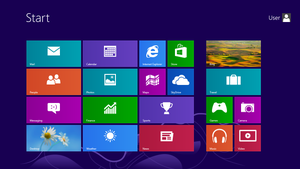
Back Windows 8 Afrikaans Windows 8 ANG ويندوز 8 Arabic Windows 8 AST Windows 8 Azerbaijani Windows 8 Bulgarian উইন্ডোজ ৮ Bengali/Bangla Windows 8 BS Windows 8 Catalan ویندۆز ٨ CKB
| Version of the Windows NT operating system | |
 Default Windows 8 start screen | |
| Developer | Microsoft |
|---|---|
| Source model | |
| Released to manufacturing | August 1, 2012[2] |
| General availability | October 26, 2012[3] |
| Final release | 6.2.9200 / December 13, 2016 |
| Marketing target | Consumer and business |
| Update method | Windows Update, Windows Server Update Services |
| Platforms | IA-32, x86-64 |
| Kernel type | Hybrid |
| Userland | Windows API, NTVDM |
| License | Trialware, Microsoft Software Assurance, MSDN subscription, DreamSpark |
| Preceded by | Windows 7 (2009) |
| Succeeded by | Windows 8.1 (2013) |
| Official website | Windows 8 (archived at Wayback Machine) |
| Support status | |
All editions (except Windows Embedded 8 Standard and PCs with the Windows 8.1 update installed):
Windows Embedded 8 Standard: | |
| Part of a series of articles on |
| Windows 8 |
|---|
| Siblings |
| Related |
Windows 8 is a major release of the Windows NT operating system developed by Microsoft. It was released to manufacturing on August 1, 2012, made available for download via MSDN and TechNet on August 15, 2012,[6] and generally released for retail on October 26, 2012.[7]
Windows 8 introduced major changes to the operating system's platform and user interface with the intention to improve its user experience on tablets, where Windows competed with mobile operating systems such as Android and iOS.[8] In particular, these changes included a touch-optimized Windows shell and start screen based on Microsoft's Metro design language, integration with online services, the Windows Store, and a new keyboard shortcut for screenshots.[9] Many of these features were adapted from Windows Phone. Windows 8 also added support for USB 3.0, Advanced Format, near-field communication, and cloud computing, as well as a new lock screen with clock and notifications. Additional security features—including built-in antivirus software, integration with Microsoft SmartScreen phishing filtering, and support for Secure Boot on supported devices—were introduced. It was the first Windows version to support ARM architecture under the Windows RT branding. CPUs without PAE, SSE2 and NX are unsupported in this version.
Windows 8 received a mostly negative reception. Although the reaction to its performance improvements, security enhancements, and improved support for touchscreen devices was positive, the new user interface was widely criticized as confusing and unintuitive, especially when used with a keyboard and mouse rather than a touchscreen. Despite these shortcomings, 60 million licenses were sold through January 2013, including upgrades and sales to OEMs for new PCs.[10]
Windows 8 was succeeded by Windows 8.1 in October 2013, which addressed some aspects of Windows 8 that were criticized by reviewers and early adopters and also incorporated various improvements.[11] Support for RTM editions of Windows 8 ended on January 12, 2016, and with the exception of Windows Embedded 8 Standard users, all users are required to install the Windows 8.1 update. Mainstream support for the Embedded Standard edition of Windows 8 ended on July 10, 2018, and extended support ended on July 11, 2023.
- ^ "Shared Source Initiative". microsoft.com. Microsoft. Retrieved October 28, 2013.
- ^ Windows 8 has reached the RM milestone Archived September 19, 2012, at the Wayback Machine. August 1, 2012
- ^ "Windows reimagined. #Windows8". Blogging Windows. Archived from the original on October 27, 2012.
- ^ "Microsoft Support Lifecycle, Windows 8". Microsoft. Retrieved January 21, 2023.
- ^ a b "Product lifecycle Windows 8 Embedded". support.microsoft.com. Retrieved August 21, 2020.
- ^ Cite error: The named reference
verge-81handsonwas invoked but never defined (see the help page). - ^ "Windows 8's delivery date: October 26". ZDNet. CBS Interactive. July 18, 2012. Retrieved September 17, 2012.
- ^ Cite error: The named reference
asd-win8adwas invoked but never defined (see the help page). - ^ Paul, Ian. "How to Take Screenshots in Windows 10, 8, and 7". Lifewire. Retrieved April 7, 2023.
- ^ Foley, Mary Jo (January 8, 2013). "Microsoft: 60 million Windows 8 licenses sold to date". ZDNet. CBS Interactive. Retrieved March 24, 2013.
- ^ Waters, Richard (May 7, 2013). "Microsoft prepares rethink on Windows 8 flagship software". Financial Times.